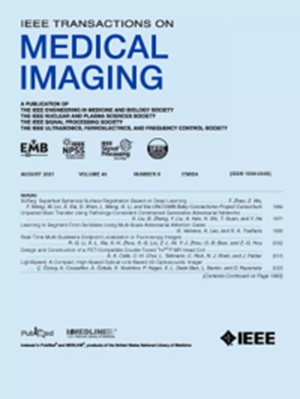MACE Risk Prediction in ARVC Patients via CMR: A Three-Tier Spatiotemporal Transformer with Pericardial Adipose Tissue Embedding.
IF 9.8
1区 医学
Q1 COMPUTER SCIENCE, INTERDISCIPLINARY APPLICATIONS
引用次数: 0
Abstract
Major adverse cardiac events (MACE) pose a high life-threatening risk to patients with arrhythmogenic right ventricular cardiomyopathy (ARVC). Cardiac magnetic resonance (CMR) has been proven to reflect the risk of MACE, but two challenges remain: limited dataset size due to the rarity of ARVC and overlapping image distributions between non-MACE and MACE patients. To address these challenges by fully leveraging the dynamic and spatial information in the limited CMR dataset, a deep learning-based risk prediction model named Three-Tier Spatiotemporal Transformer (TTST) is proposed in this paper, which utilizes three transformer-based tiers to sequentially extract and fuse features from three domains: the 2D spatial domain of each slice, the temporal dimension of slice sequence and the inter-slice depth dimension. In TTST, a pericardial adipose tissue (PAT) embedding unit is proposed to incorporate the dynamic and positional information of PAT, a key biomarker for distinguishing MACE from non-MACE based on its thickening and reduced motion, as prior knowledge to reduce reliance on large-scale datasets. Additionally, a patch voting unit is introduced to pick out local features that highlight more indicative regions in the heart, guided by the PAT embedding information. Experimental results demonstrate that TTST outperforms existing classification methods in MACE prediction (internal: AUC = 0.89, ACC = 84.02%; external: AUC = 0.87, ACC = 86.21%). Clinically, TTST achieves effective risk prediction performance either independently (C-index = 0.744) or in combination with the existing 5-year risk score model (increasing C-index from 0.686 to 0.777). Code and dataset are accessible at https://github.com/DFLAG-NEU.通过CMR预测ARVC患者的MACE风险:心包脂肪组织埋置的三层时空转换器。
重大心脏不良事件(MACE)对心律失常性右室心肌病(ARVC)患者具有很高的危及生命的风险。心脏磁共振(CMR)已被证明可以反映MACE的风险,但仍然存在两个挑战:由于ARVC的罕见性,数据集大小有限,以及非MACE和MACE患者之间的重叠图像分布。为了充分利用有限CMR数据集的动态和空间信息来解决这些挑战,本文提出了一种基于深度学习的风险预测模型——三层时空变压器(three - tier Spatiotemporal Transformer, TTST),该模型利用基于三层变压器的层序从三个领域依次提取和融合特征:每个切片的二维空间域、切片序列的时间维度和片间深度维度。在TTST中,提出了一种心包脂肪组织(PAT)嵌入单元,将PAT的动态和位置信息作为先验知识,以减少对大规模数据集的依赖。PAT是基于其增厚和运动减少来区分MACE与非MACE的关键生物标志物。此外,引入了一个补丁投票单元,在PAT嵌入信息的指导下,挑选出心脏中突出更多指示区域的局部特征。实验结果表明,TTST在MACE预测方面优于现有的分类方法(内部:AUC = 0.89, ACC = 84.02%;外部:AUC = 0.87, ACC = 86.21%)。在临床上,无论是单独使用TTST (C-index = 0.744),还是与现有的5年风险评分模型联合使用TTST (C-index由0.686提高到0.777)均能获得有效的风险预测效果。代码和数据集可访问https://github.com/DFLAG-NEU。
本文章由计算机程序翻译,如有差异,请以英文原文为准。
求助全文
约1分钟内获得全文
求助全文
来源期刊

IEEE Transactions on Medical Imaging
医学-成像科学与照相技术
CiteScore
21.80
自引率
5.70%
发文量
637
审稿时长
5.6 months
期刊介绍:
The IEEE Transactions on Medical Imaging (T-MI) is a journal that welcomes the submission of manuscripts focusing on various aspects of medical imaging. The journal encourages the exploration of body structure, morphology, and function through different imaging techniques, including ultrasound, X-rays, magnetic resonance, radionuclides, microwaves, and optical methods. It also promotes contributions related to cell and molecular imaging, as well as all forms of microscopy.
T-MI publishes original research papers that cover a wide range of topics, including but not limited to novel acquisition techniques, medical image processing and analysis, visualization and performance, pattern recognition, machine learning, and other related methods. The journal particularly encourages highly technical studies that offer new perspectives. By emphasizing the unification of medicine, biology, and imaging, T-MI seeks to bridge the gap between instrumentation, hardware, software, mathematics, physics, biology, and medicine by introducing new analysis methods.
While the journal welcomes strong application papers that describe novel methods, it directs papers that focus solely on important applications using medically adopted or well-established methods without significant innovation in methodology to other journals. T-MI is indexed in Pubmed® and Medline®, which are products of the United States National Library of Medicine.
 求助内容:
求助内容: 应助结果提醒方式:
应助结果提醒方式:


